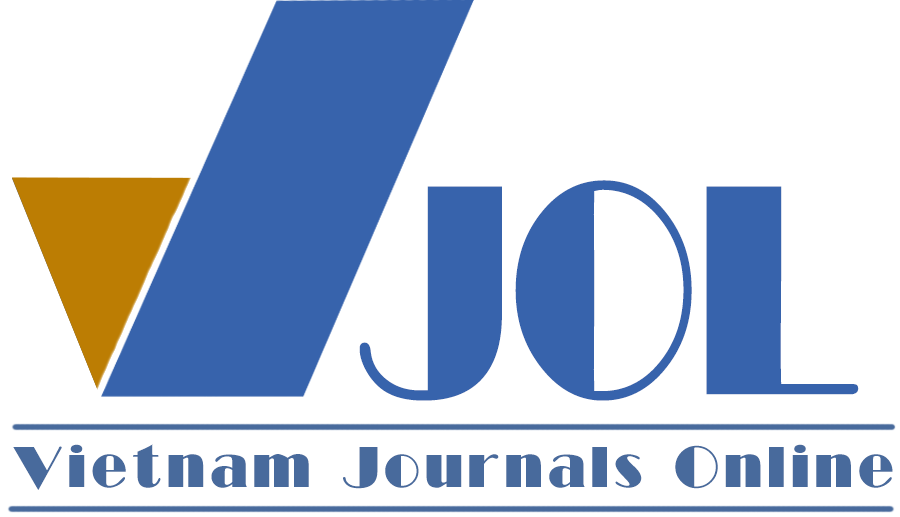Roles of absorbent capacity, innovation capacity and responsible innovation in sustainable competition advantage: A study in the hospitality industry
Authors
DOI: https://doi.org/10.57110/jebvn.v4i1.281Keywords:
Responsible innovation , sustainable competition advantage, absorbent capacity, innovation capacityReferences
Barney, J. (1991). Firm resources and sustained competitive advantage. Journal of Management, 17(1), 99-120. https://doi.org/10.1177/014920639101700108
Barney, J. B. (1995). Looking inside for competitive advantage. Academy of Management Perspectives, 9(4), 49-61. https://doi.org/10.5465/ame.1995.9512032192
Camisón, C., & Villar-López, A. (2014). Organizational innovation as an enabler of technological innovation capabilities and firm performance. Journal of Business Research, 67(1), 2891-2902. https://doi.org/10.1016/j.jbusres.2012.06.004
Cao, X., Lv, D., & Xing, Z. (2020). Innovative resources, promotion focus, and responsible innovation: The moderating roles of adaptive governance. Sustainability, 12(7), 2860. https://doi.org/10.3390/su12072860
Chatterjee, S., Chaudhuri, R., & Vrontis, D. (2022). Knowledge sharing in international markets for product and process innovation: Moderating role of firm's absorptive capacity. International Marketing Review, 39(3), 706-733. https://doi.org/10.1108/IMR-11-2020-0261
Chen, S. T., & Chang, B. G. (2012). The effects of absorptive capacity and decision speed on organizational innovation: A study of organizational structure as an antecedent variable. Contemporary Management Research, 8(1). https://doi.org/10.7903/cmr.7996
Chen, Y.-S., Lin, M.-J. J., & Chang, C.-H. (2009). The positive effects of relationship learning and absorptive capacity on innovation performance and competitive advantage in industrial markets. Industrial Marketing Management, 38(2), 152-158. https://doi.org/10.1016/j.indmarman.2008.12.003
Cohen, W. M., & Levinthal, D. A. (1990). Absorptive capacity: A new perspective on learning and innovation. Administrative Science Quarterly, 35(1), 128-152. https://doi.org/10.2307/2393553
Crossan, M. M., & Apaydin, M. (2010). A multi‐dimensional framework of organizational innovation: A systematic review of the literature. Journal of Management Studies, 47(6), 1154-1191. https://doi.org/10.1111/j.1467-6486.2009.00880.x
Easterby‐Smith, M., Lyles, M. A., & Peteraf, M. A. (2009). Dynamic capabilities: Current debates and future directions. British Journal of Management, 20, S1-S8. https://doi.org/10.1111/j.1467-8551.2008.00609.x
Francis, D., & Bessant, J. (2005). Targeting innovation and implications for capability development. Technovation, 25(3), 171-183. https://doi.org/10.1016/j.technovation.2004.03.004
Grant, R. M. (1991). The resource-based theory of competitive advantage: Implications for strategy formulation. California Management Review, 33(3), 114-135. https://doi.org/10.2307/41166664
Hadj, T., Omri, A., & Al-Tit, A. (2020). Mediation role of responsible innovation between CSR strategy and competitive advantage: Empirical evidence for the case of Saudi Arabia enterprises. Management Science Letters, 10(4), 747-762. https://doi.org/10.5267/j.msl.2019.10.022
Hair, J. F., Black, W. C., Babin, B. J., & Anderson, R. E. (2009). Multivariate data analysis (7th ed.). Pearson.
Halme, M., & Korpela, M. (2014). Responsible innovation toward sustainable development in small and medium‐sized enterprises: A resource perspective. Business Strategy and the Environment, 23(8), 547-566. http://doi.org/10.1002/bse.1801
Hana, U. (2013). Competitive advantage achievement through innovation and knowledge. Journal of Competitiveness, 5(1), 82-96. https://doi.org/10.7441/joc.2013.01.06
Barney, J. (1991). Firm resources and sustained competitive advantage. Journal of Management, 17(1), 99-120. https://doi.org/10.1177/014920639101700108
Barney, J. B. (1995). Looking inside for competitive advantage. Academy of Management Perspectives, 9(4), 49-61. https://doi.org/10.5465/ame.1995.9512032192
Camisón, C., & Villar-López, A. (2014). Organizational innovation as an enabler of technological innovation capabilities and firm performance. Journal of Business Research, 67(1), 2891-2902. https://doi.org/10.1016/j.jbusres.2012.06.004
Cao, X., Lv, D., & Xing, Z. (2020). Innovative resources, promotion focus and responsible innovation: The moderating roles of adaptive governance. Sustainability, 12(7), 2860. https://doi.org/10.3390/su12072860
Chatterjee, S., Chaudhuri, R., & Vrontis, D. (2022). Knowledge sharing in international markets for product and process innovation: moderating role of firm's absorptive capacity. International Marketing Review, 39(3), 706-733. https://doi.org/10.1108/IMR-11-2020-0261
Chen, S. T., & Chang, B. G. (2012). The effects of absorptive capacity and decision speed on organizational innovation: a study of organizational structure as an antecedent variable. Contemporary Management Research, 8(1). https://doi.org/10.7903/cmr.7996
Chen, Y.-S., Lin, M.-J. J., & Chang, C.-H. (2009). The positive effects of relationship learning and absorptive capacity on innovation performance and competitive advantage in industrial markets. Industrial Marketing Management, 38(2), 152-158. https://doi.org/10.1016/j.indmarman.2008.12.003
Cohen, W. M., & Levinthal, D. A. (1990). Absorptive capacity: A new perspective on learning and innovation. Administrative Science Quarterly,
-152. https://doi.org/10.2307/2393553
Crossan, M. M., & Apaydin, M. (2010). A multi‐dimensional framework of organizational innovation: A systematic review of the literature. Journal of Management Studies, 47(6), 1154-1191. https://doi.org/10.1111/j.1467-6486.2009.00880.x
Easterby‐Smith, M., Lyles, M. A., & Peteraf, M. A. (2009). Dynamic capabilities: Current debates and future directions. British Journal of Management, 20, S1-S8. https://doi.org/10.1111/j.1467-8551.2008.00609.x
Francis, D., & Bessant, J. (2005). Targeting innovation and implications for capability development. Technovation, 25(3), 171-183. https://doi.org/10.1016/j.technovation.2004.03.004
Grant, R. M. (1991). The resource-based theory of competitive advantage: implications for strategy formulation. California Management Review, 33(3), 114-135. https://doi.org/10.2307/41166664
Hadj, T., Omri, A., & Al-Tit, A. (2020). Mediation role of responsible innovation between CSR strategy and competitive advantage: Empirical evidence for the case of Saudi Arabia enterprises. Management Science Letters, 10(4), 747-762. https://doi.org/10.5267/j.msl.2019.10.022
Hair, J. F., Black, W. C., Babin, B. J. & Anderson, R. E. (2009). Multivariate Data Analysis. 7th edition. Pearson.
Halme, M., & Korpela, M. (2014). Responsible innovation toward sustainable development in small and medium‐sized enterprises: A resource perspective. Business Strategy and the Environment, 23(8), 547-566. http://doi.org/10.1002/bse.1801
Hana, U. (2013). Competitive advantage achievement through innovation and knowledge. Journal of Competitiveness, 5(1), 82-96. https://doi.org/10.7441/joc.2013.01.06
Haned, N., Mothe, C., & Nguyen-Thi, T. U. (2014). Firm persistence in technological innovation: the relevance of organizational innovation. Economics of Innovation and New Technology, 23(5-6), 490-516. https://doi.org/10.1080/10438599.2014.895509
Helfat, C. E. (1997). Know‐how and asset complementarity and dynamic capability accumulation: the case of R&D. Strategic Management Journal, 18(5), 339-360. https://doi.org/10.1002/(SICI)1097-0266(199705)18:5%3C339::AID-SMJ883%3E3.0.CO;2-7
Hossain, M. S., Kannan, S. N., & Raman Nair, S. K. K. (2021). Factors influencing sustainable competitive advantage in the hospitality industry. Journal of Quality Assurance in Hospitality & Tourism, 22(6), 679-710. https://doi.org/10.1080/1528008X.2020.1837049
IHG Hotels & Resorts. (2021). Journey to Tomorrow. IHG Hotels & Resorts. ihgplc.com
Jap, S. D. (1999). Pie-expansion efforts: Collaboration processes in buyer–supplier relationships. Journal of Marketing Research, 36(4), 461-475. https://doi.org/10.1177/002224379903600405
Kuncoro, W., & Suriani, W. O. (2018). Achieving sustainable competitive advantage through product innovation and market driving. Asia Pacific Management Review, 23(3), 186-192. https://doi.org/10.1016/j.apmrv.2017.07.006
Lane, P. J., Koka, B. R., & Pathak, S. (2006). The reification of absorptive capacity: A critical review and rejuvenation of the construct. Academy of Management Review, 31(4), 833-863. https://doi.org/10.5465/amr.2006.22527456
Liao, S.-h., Fei, W.-C., & Chen, C.-C. (2007). Knowledge sharing, absorptive capacity, and innovation capability: An empirical study of Taiwan's knowledge-intensive industries. Journal of Information Science, 33(3), 340-359. https://doi.org/10.1177/0165551506070739
Madhavan, M., Sharafuddin, M. A., & Chaichana, T. (2022). Impact of Business Model Innovation on Sustainable Performance of Processed Marine Food Product SMEs in Thailand - A PLS-SEM Approach. Sustainability, 14(15), 9673. https://doi.org/10.3390/su14159673
Matthyssens, P., Pauwels, P., & Vandenbempt, K. (2005). Strategic flexibility, rigidity and barriers to the development of absorptive capacity in business markets: Themes and research perspectives. Industrial Marketing Management, 34(6), 547-554. https://doi.org/10.1016/j.indmarman.2005.03.004
Müller, J. M., Buliga, O., & Voigt, K.-I. (2021). The role of absorptive capacity and innovation strategy in the design of industry 4.0 business Models-A comparison between SMEs and large enterprises. European Management Journal, 39(3), 333-343. https://doi.org/10.1016/j.emj.2020.01.002
Najafi-Tavani, S., Najafi-Tavani, Z., Naudé, P., Oghazi, P., & Zeynaloo, E. (2018). How collaborative innovation networks affect new product performance: Product innovation capability, process innovation capability, and absorptive capacity. Industrial Marketing Management, 73, 193-205. https://doi.org/10.1016/j.indmarman.2018.02.009
Porter, M. E. (1985). Competitive Strategy: Creating and Sustaining Superior Performance. New York: Free Press.
Sancho-Zamora, R., Gutiérrez-Broncano, S., Hernández-Perlines, F., & Peña-García, I. (2021). A multidimensional study of absorptive capacity and innovation capacity and their impact on business performance. Frontiers in Psychology, 12, 751997. https://doi.org/10.3389/fpsyg.2021.751997
Schmidt, T., & Rammer, C. (2006). The determinants and effects of technological and non technological innovations–Evidence from the German CIS IV. Zentrum für Europäische Wirtschaftsforschung (ZEW), Mannheim.
Serafin, V. F., Severo, E. A., Guimarães, J. C. F. d., Rotta, C., & Philereno, D. C. (2022). Innovation and human resources practices in companies of southern Brazil. Revista de Administração da UFSM, 15,
-61. https://doi.org/10.5902/1983465963785
Teece, D. J., Pisano, G., & Shuen, A. (1997). Dynamic capabilities and strategic management. Strategic Management Journal, 18(7), 509-533. https://doi.org/10.1002/(SICI)1097-0266(199708)18:7%3C509::AID-SMJ882%3E3.0.CO;2-Z
Thompson, V. A. (1965). Bureaucracy and innovation. Administrative Science Quarterly, 1-20. https://doi.org/10.2307/2391646
Vietnam National Authority of Tourism (2023). vietnamtourism.gov.vn.
Von Schomberg, R. (2012). Prospects for technology assessment in a framework of responsible research and innovation. Technikfolgen Abschätzen Lehren: Bildungspotenziale Transdisziplinärer Methoden, 39-61. https://doi.org/10.1007/978-3-531-93468-6_2
Wernerfelt, B. (1984). A resource‐based view of the firm. Strategic Management Journal, 5(2), 171-180. https://doi.org/10.1002/smj.4250050207
Xie, X., Wu, Y., & Tejerob, C. B.-G. (2022). How responsible innovation builds business network resilience to achieve sustainable performance during global outbreaks: An extended resource-based view. IEEE Transactions on Engineering Management.
Zahra, S. A., & George, G. (2002). Absorptive capacity: A review, reconceptualization, and extension. Academy of Management Review, 27(2), 185-203. https://doi.org/10.5465/amr.2002.6587995
Downloads
Downloads
Published
Abstract View
PDF Downloaded
How to Cite
Issue
Section
License
Copyright (c) 2024 Nguyễn Thị Huyền Ngân, Nguyễn Viết Thái

This work is licensed under a Creative Commons Attribution-NonCommercial 4.0 International License.
by VNU Journal of Economics and Business
Most read articles by the same author(s)
- Nguyen Thi Huyen Ngan, Green value co-creation behavior: The role of green practices and green certifications , VNU JOURNAL OF ECONOMICS AND BUSINESS: Vol. 5 No. 3






